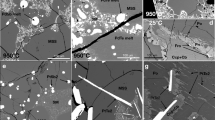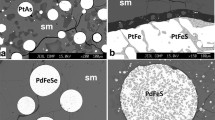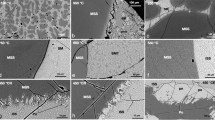Abstract
We evaluate experimentally the role of temperature and metal/Te ratio on the composition and crystallization temperature of sulfides and tellurides in the Fe–Cu–Ni–Pd–Pt–Te–S system. The monosulfide–sulfide melt partition coefficients decrease with increasing Te concentration and decreasing S/Te ratio of the bulk composition because Pt and Pd are strongly complexed by Te and thus stabilized in the melt phase. The solubility of Te in Fe-rich monosulfide solid solution and Cu-rich intermediate solid solution is around 0.2 wt% and largely insensitive to temperature down to 320°C, indicating that Te substitutes in sulfides as an anion replacing S. Solid solution between moncheite PtTe2 and merenskyite PdTe2 is more limited than implied by natural telluride phase compositions. Solid solution between tellurides with variable metal/Te stoichiometry also appears to be limited, again in contrast to natural phase compositions. Natural tellurides are compositionally more flexible than the experimental compositions synthesized here. It is argued, therefore, that many natural tellurides coexisting with sulfides may be metastable, i.e. modified by exsolution of a Ni–Te component from the coexisting high-temperature sulfides. From Te concentrations in monosulfide solid solution it is deduced that natural sulfide–telluride assemblages record equilibration temperatures as low as 200–250°C. With respect to Te and precious metal mineralization, no systematic temperature difference exists between sulfide–telluride ores referred to in the descriptive ore petrography literature as magmatic and ores termed hydrothermal in origin.






Similar content being viewed by others
References
Ballhaus C, Stumpfl EF (1986) Sulfide and platinum mineralization in the Merensky reef: evidence from hydrous silicates and fluid inclusions. Contrib Mineral Petrol 94:193–204
Ballhaus C, Ryan CG (1995) Platinum-group elements in the Merensky reef. I. PGE in solid solution in base metal sulfides and the down-temperature equilibration history of Merensky ores. Contrib Mineral Petrol 122:241–251
Ballhaus C, Ulmer P (1995) Platinum-group elements in the Merensky reef. II. Experimental solubility of Pt and Pd in synthetic Fe1−x S between 950 and 450° under controlled f S2 and f H2. Geochim Cosmochim Acta 59:4881–4888
Ballhaus C, Tredoux M, Spaeth A (2001) Phase relations in the Fe–Ni–Cu–PGE–S system at magmatic temperature and application to massive sulphide ores of the Sudbury igneous complex. J Petrol 10:1911–1926
Barkov AY, Laflamme JHG, Cabri LJ, Martin RF (2002) Platinum-group minerals from the Welgreen Ni–Cu–PGE deposit, Yukon, Canada. Can Mineral 40:651–669
Barkov A, Thibault Y, Laajoki KVO, Melezhik VA, Nilsson LP (1999) Zoning and substitutions in Co–Ni–(Fe)–PGE sulfarsenides from the Mount General Skya layered intrusion, Arctic Russia. Can Mineral 37:127–142
Cabri LJ, Laflamme JHG (1976) The mineralogy of the platinum-group elements from some copper–nickel deposits of the Sudbury area, Ontario. Econ Geol 71:1159–1195
Cawthorn RG, Lee CA, Schouwstra RP, Mellowship P (2002) Relationship between PGE and PGM in the Bushveld Complex. Can Mineral 40:311–328
Craig JR (1973) Pyrite–pentlandite and other low temperature assemblages in the Fe–Ni–S system. Am J Sci 273:496–510
Etschmann B, Pring A, Putnis A, Grguric BA, Studer A (2004) A kinetic study of the exsolution of pentlandite (Ni,Fe)9S8 from the monosulfide solid solution (Fe,Ni)S. Am Mineral 89:39–50
Farrow CFG, Watkinson DH (1992) Alteration and the role of fluids in Ni, Cu, and platinum-group element deposition, Sudbury Igneous Complex Contact, Onaping-Levack area, Ontario. Mineral Petrol 46:67–83
Fleet ME, Chryssoulis SL, Stone WE, Weisener CG (1993) Partitioning of the platinum-group elements in the Fe–Ni–Cu–S system: experiments on the fractional crystallization of sulfide melt. Contrib Mineral Petrol 115:36–44
Garuti G, Rinaldi R (1986) Mineralogy of melonite-group and other tellurides from the Ivrea–Verbano basic complex, western Italian Alps. Econ Geol 81:1213–1217
Gervilla F, Kojonen K (2002) The platinum-group minerals in the upper section of the Keivitsansarvi Ni–Cu–PGE deposit, northern Finland. Can Mineral 40:377–394
Gervilla F, Sanchez-Anguita A, Acevedo RD, Fenoll Hach-Ali P, Paniagua A (1997) Platinum-group element sulpharsenides and Pd bismuthotellurides in the metamorphosed Ni–Cu deposit at Las Aguilas (Province of San Luis, Argentina). Min Mag 61:861–877
Gervilla F, Leblanc M, Torres Ruiz J, Hachali PF (1996) Immiscibility between arsenide and sulfide melts: a mechanism for the concentration of noble metals. Can Mineral 34:485–502
Gervilla F, Papunen H, Kojonen K, Johanson B (1998) Platinum, palladium, and gold-rich arsenide ores from the Kylmakoski Ni–Cu deposit (Vammala Nickel Belt, SW Finland). Mineral Petrol 64:163–185
Hattori KH, Arai S, Clarke DB (2002) Selenium, tellurium, arsenic and antimony contents of primary mantle sulfides. Can Mineral 40:637–650
Helmy HM (2004) Cu–Ni–PGE mineralization in the Genina Gharbia mafic–ultramafic intrusion, Eastern Desert, Egypt. Can Mineral 42:351–370
Helmy HM (2005) Melonite-group minerals and other tellurides from three Cu–Ni–PGE prospects, Eastern Desert, Egypt. Ore Geol Rev 26:305–324
Helmy HM, Mogessie A (2001) Gabbro Akarem, Eastern Desert, Egypt: Cu–Ni–PGE mineralization in a concentrically zoned mafic–ultramafic complex. Mineral Depos 36:58–71
Helmy HM, Stumpfl EF, Kamel OA (1995) Platinum-group minerals from the metamorphosed Abu Swayel Cu–Ni–PGE mineralization, South Eastern Desert, Egypt. Econ Geol 90:2350–2360
Hertogen J, Jassens MJ, Palme H (1980) Trace elements in ocean ridge basalts glasses: implications for fractionation during mantle evolution and petrogenesis. Geochim Cosmochim Acta 44:2125–2143
Holwell DA, McDonald I (2006) Partitioning of platinum-group elements in the Platreef at Overysel, northern Bushveld Complex: a combined PGM and LA ICP-MS study. Contrib Mineral Petrol (in press)
Hoffman E, MacLean WH (1976) Phase relations of michenerite and merenskyite in the Pd–Bi–Te system. Econ Geol 71:1461–1468
Hudson DR (1986) Platinum-group minerals from the Kambalda nickel deposits, Western Australia. Econ Geol 81:1218–1225
Kaneda H, Takenouchi S, Shoji T (1986) Stability of pentlandite in the Fe–Ni–Co–S system. Mineral Depos 21:169–180
Kim WS, Chao AG (1991) Phase relations in the system Pd–Sb–Te. Can Mineral 29:401–409
Kingston GA, Eldosuky BT (1982) A contribution on the platinum-group mineralogy of the Merensky reef at the Rustenburg platinum mine. Econ Geol 77:1367–1384
Li C, Barnes S-J, Makovicky E, Rose-Hansen J, Makovicky M (1996) Partitioning of nickel, copper, iridium, rhenium, platinum, and palladium between monosulfide solid solution and sulfide liquid: effects of composition and temperature. Geochim Cosmochim Acta 60:1231–1238
Magyarosi Z, Watkinson DH, Jones PC (2002) Mineralogy of Ni–Cu–platinum-group element sulfide ore in the 825 and 810 orebodies, Copper Clif South Mine, and P–T–X conditions during the formation of platinum-group minerals. Econ Geol 97:1471–1486
Medvedeva ZS, Klochko MA, Kuznetsov AG, Andreyeva SN (1961) Structural diagram of the Pd–Te alloy system (in Russian). Zhurnal Neorganicheskoy Khimii 6:1737–1739
Melcher F, Lodziak J (2006) Platinum-group minerals of concentrates from the Driekop platinum pipe, Eastern Bushveld Complex—tribute to Eugen F. Stumpfl. N Jb Mineral (in press)
Misra KC, Fleet ME (1973) The chemical composition of synthetic and natural pentlandite assemblages. Econ Geol 68:518–539
Mulja T, Mitchell RH (1991) The Geordie Lake intrusion, Coldwell Complex, Ontario: a palladium and tellurium-rich disseminated sulfide occurrence derived from an evolved tholeiitic magma. Econ Geol 86:1050–1069
Naldrett AJ (2004) Magmatic sulfide deposits. Springer, Berlin Heidelberg New York, p 727
Oberthür T, Weiser TW, Gast L, Kojonen K (2003) Geochemistry and mineralogy of platinum-group elements at Hartley Platinum Mine, Zimbabwe. Part 1. Primary distribution patterns in pristine ores of the Main Zone of the Great Dyke. Mineral Depos 38:327–343
O’Neill HSC, Mavrogenes JA (2002) The sulfide capacity and the sulfur content at sulfide saturation of silicate melts at 1400 degrees C and 1 bar. J Petrol 43:1049–1087
Palme H, O’Neill HStC (2003) Cosmochemical estimates of mantle composition, 1–38. In Carlson RW (ed) The mantle and core, Treatise on Geochemistry, Vol 2 (Holland HD Turekian KK eds.), Elsevier, Oxford
Piña R, Gervilla F, Ortega L, Lunar R (2006) Mineralogy and geochemistry of platinum-group elements in the Aguablanca Ni–Cu Deposit (SW Spain). Mineral Petrol (in press)
Prichard HM, Barnes SJ, Maier WD, Fisher PC (2004) Variations in the nature of the platinum-group minerals in a cross-section through the Merensky reef at Impala Platinum: Implications for the mode of formation of the reef. Can Mineral 42:423–437
Rowell WF, Edgar AD (1986) Platinum-group element mineralization in a hydrothermal Cu–Ni sulfide occurrence, Rathbun Lake, northeastern Ontario. Econ Geol 81:1272–1277
Rucklidge J (1969) Electron microprobe investigation of platinum metal minerals from Ontario. Can Mineral 9:617–628
Tarkian M, Koopmann G (1995) Platinum-group minerals in the Santo-Tomas-II (Philex) porphyry copper–gold deposit, Luzon Island, Phillipines. Mineral Depos 30:39–47
Yi W, Halliday AN, Alt JC, Lee D-C, Rehkämper M, Garcia MO, Langmuir CH, Su Y (2000) Cadmium, indium, tin, tellurium, and sulfur in oceanic basalts: implications for chalcophile element fractionation in the Earth. J Geophys Res 105:18927–18948
Acknowledgments
This work was financed generously by a DFG scholarship to Hassan Helmy and by the DFG grants BA 964/23-1 and 24-1 to Chris Ballhaus. The polished sections were prepared by Paul Löbke. Claudia Meyer is thanked for logistic help during Hassan Helmy’s sabbatical in Münster. David Holwell, Thomas Oberthür, and Frank Melcher kindly provided unpublished telluride phase compositions from the Platreef (northern Bushveld Complex), the Hartley mine (Great Dyke), and the Driekop pipe (Bushveld Complex), respectively. Comments by Giorgio Garuti and an anonymous reviewer greatly improved the paper.
Author information
Authors and Affiliations
Corresponding author
Additional information
Communicated by J. Hoefs.
Rights and permissions
About this article
Cite this article
Helmy, H.M., Ballhaus, C., Berndt, J. et al. Formation of Pt, Pd and Ni tellurides: experiments in sulfide–telluride systems.. Contrib Mineral Petrol 153, 577–591 (2007). https://doi.org/10.1007/s00410-006-0163-7
Received:
Accepted:
Published:
Issue Date:
DOI: https://doi.org/10.1007/s00410-006-0163-7




